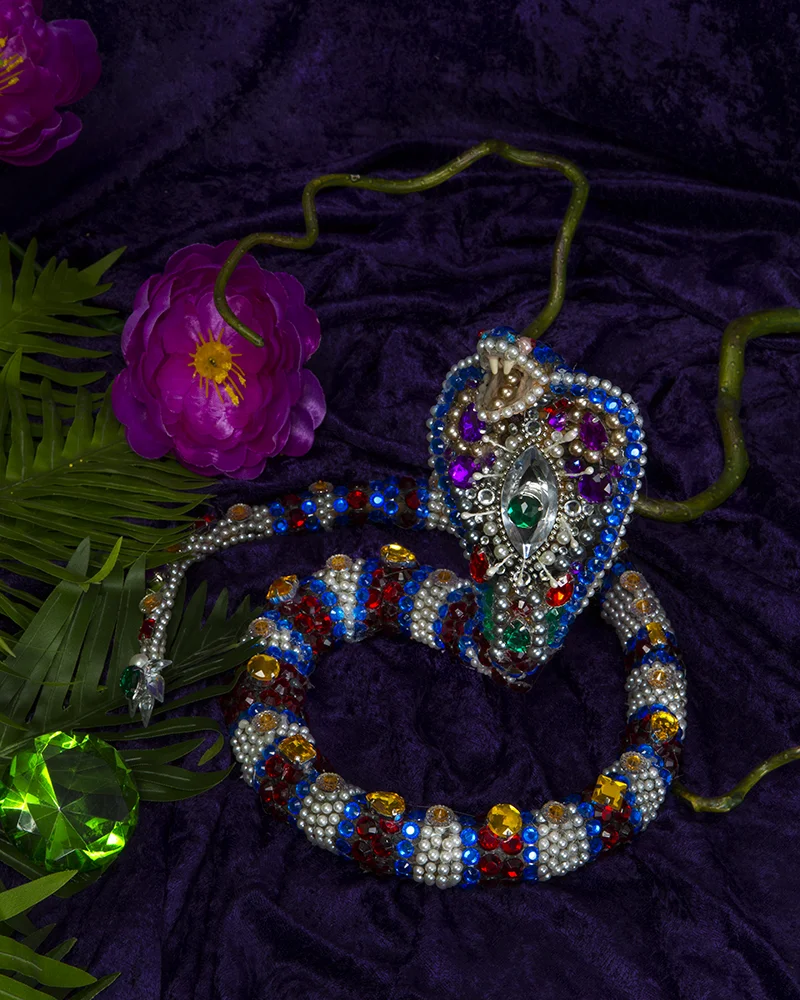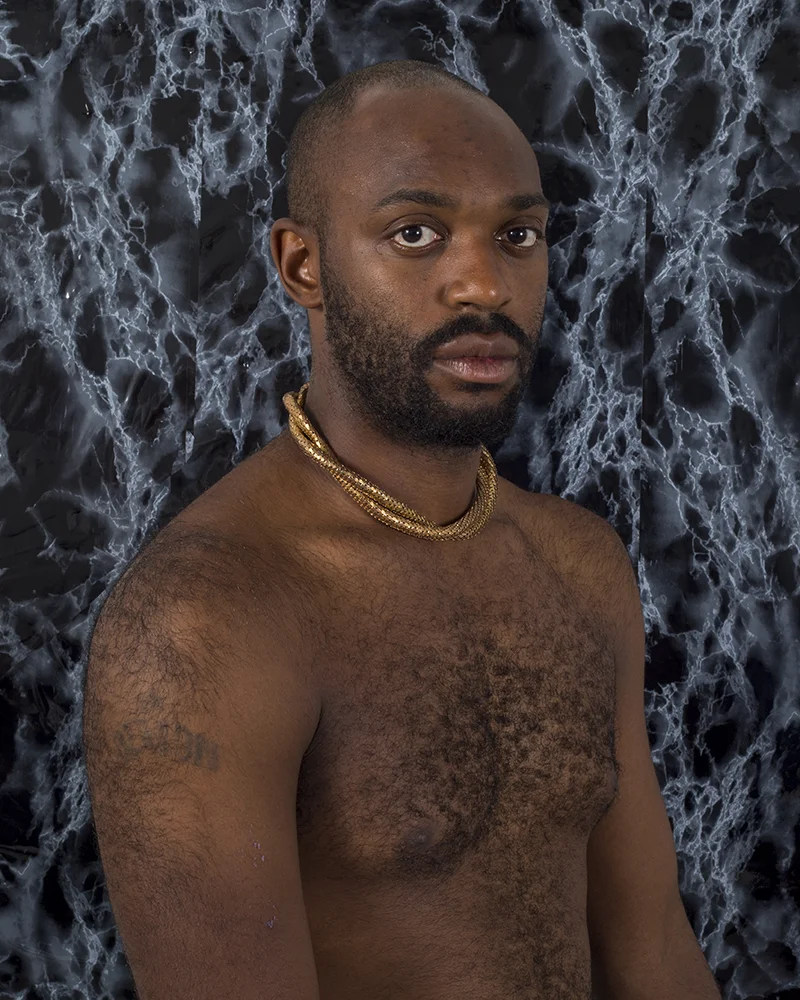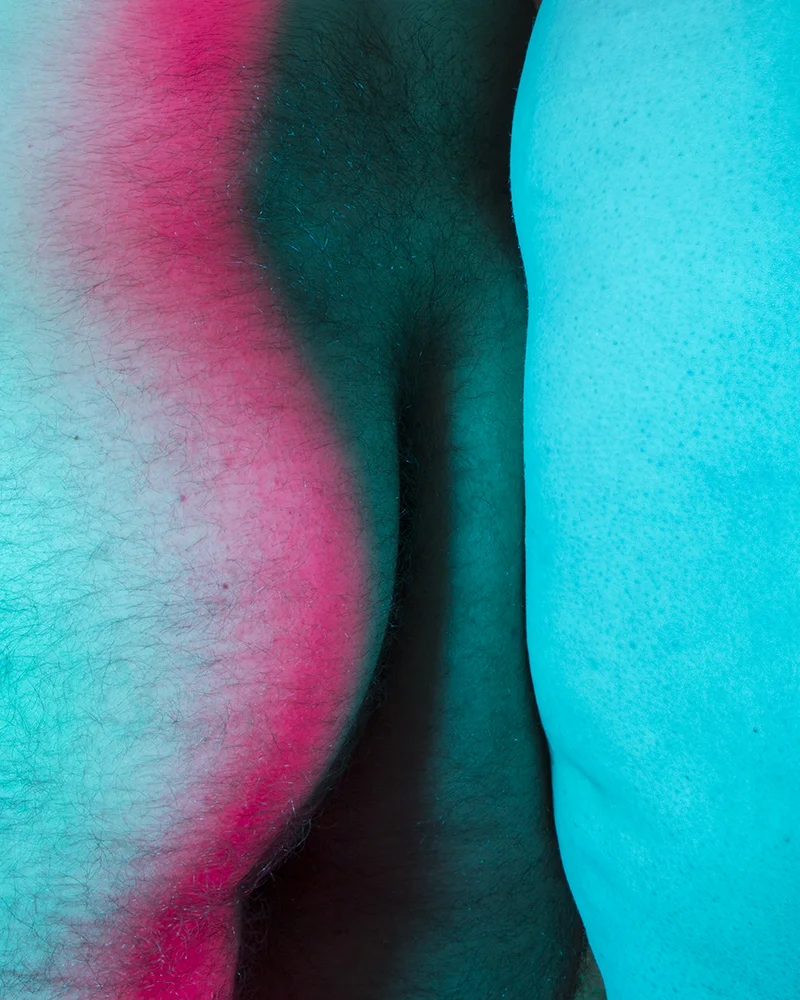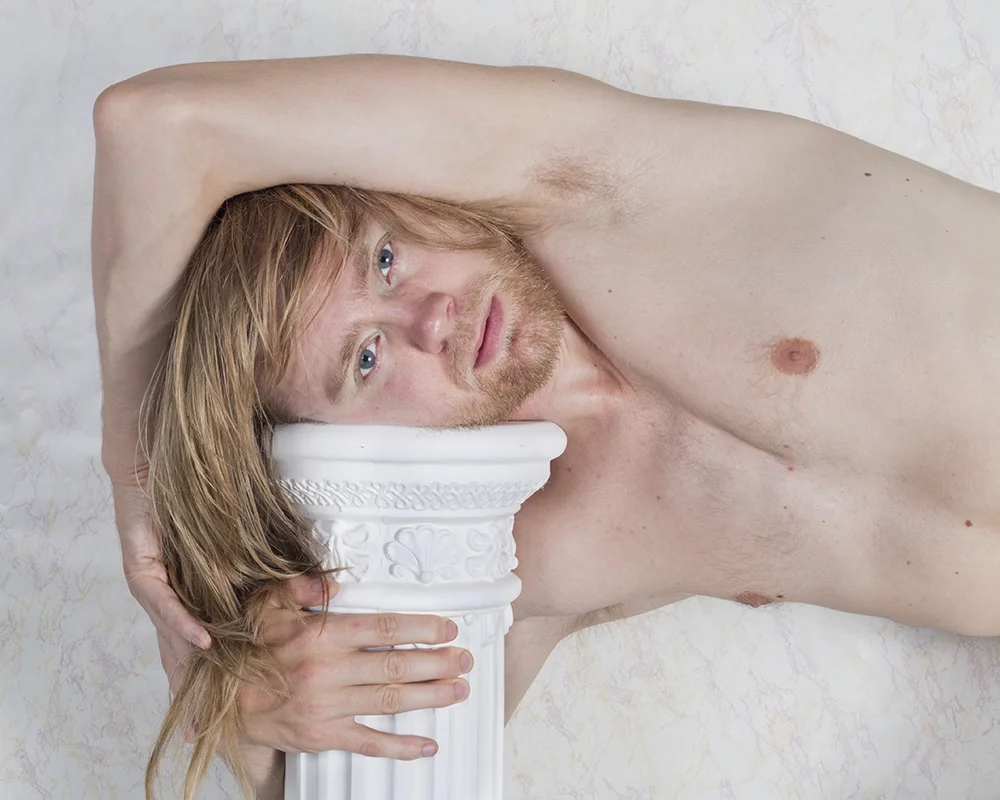Rachel Stern's portraits and still-life photographs in highly constructed studio environments swap natural and fabricated scenarios, evoking a panic and confusion in her viewers. Her references include a range of sources, from current pop-cultural icons and drag-queen subcultures to classical Greco-Roman iconography, fusing high and low culture with seamless ease. Models mimic classical poses; arms, breasts, and other body parts protrude into the frame, and ritualistic symbols sit quietly upon plinths and other surfaces, prodding viewers to question their historical anchor, relationship and relevance. Her pop-up solo exhibition "A Certain Age," presented by Humble Arts Foundation opens this Friday, June 5th at 6pm at The Common in Brooklyn, NY as part Bushwick Open Studios. In advance of her show, we spent some quality internet time with Rachel to get a deeper dive into her work, and the generous individuals who have helped to shape her artistic practice.
Humble: What do you aim to communicate with your pictures?
Rachel Stern: Paradise, escape, and beauty. Primarily I am interested in being constructivist. I want to add some little chunk to the world. I have lots of little interests that fuel what I make (art history, visual literacy, queer beauty, feminist histories, etc.) but those are more important to the making than to the reading. What I want to communicate are little moments of wonder wherein an audience can find respite from the world and perhaps a suggestion about personal determination in how they perceive their daily lives.
What attracts you to making studio-based work?
The longer I have worked inside, the more the distinction between the studio and the greater world becomes blurred. It's a place where I can be free and specific but as I am using materials designed for and otherwise existing in ‘the world’ the studio is not entirely separated from the rest of the continuum of time/space/life. The difference between a set and a place is mostly just how durable and lasting it is. In this regard Starbucks is basically a set for a coffeehouse. If we think about the definition of kitsch at is core, it has very little to do with bad taste. I think the bad taste element is a linguistic assimilation of classism.
Kitsch is really a facsimile version of something else. It is about loss. If one cannot access a Rococo palace to live in, a resin cast vase of the same ilk might present a domestic place for meditation on that desire or more tragically on the inability to fully actualize and access that desire. In that sense the studio is for me a kitsch version of my life. It is a place where I can access and enact desires that I otherwise wouldn't be able to approach or live within.
You often collaborate with men as "muses." What's driving this?
For me photography is about love. That's what Mary Ellen Mark, Thomas Roma, Henry Horenstein and Harry Callahan taught me. Many of my favorite photographers photographed muses obsessively and I can't get enough of looking at the people they couldn’t get enough of photographing; Peter Hujar’s pictures of David Wojnarowicz, Claud Cahun’s photographs of herself, all of F Holland Day. I truly love the people I photograph and I hope that that is tangible on the other side for an audience. I photograph men because it is honest. Because they are beautiful and strange to me. I’ve seen a lot of photographs of women. I’ve seen a lot of good photographs of women. I can’t really make them. At least not right now.
Photographing men is exciting because it is something I cannot do on my own. As I am not male I require a male collaborator. Photographing men is both an expression of some element within me and something entirely outside of me that is desirous. I am interested specifically in masculine beauty that is created for or tailored to my tastes as a woman. A muse is someone who believes in the artists brand of beauty and wants to participate in it - to collaborate by adding themselves, their gaze back at the camera. It means a lot to me when people allow me to photograph them. It is very generous to relinquish the power of imaging the self and I am grateful for that generosity.
You describe queer identities being at play throughout your work. Would you define your work as being "queer art?”
Without question my work is queer. It is of the utmost importance to me that my subjects like the photographs I make of them, that I provide a space for people to feel beautiful - to feel like themselves. This, to me is queer, because it is about claiming ownership of something highly individualized which is often lost in the sea of the collective or the standard. It is about claiming ones own power without anyone else’s permission. Labels are hard and queer is complex but simply my work can’t help but be queer because it is about real people.
In your statement, you talk about "hyper opulence" and "reality." What's this all about?
Reality is hyper opulent. Opulence is a way of seeing and engaging more than it is a material quality. There were these young adult chapter books I would read as a kid each of which focused on a different princess from some distinct historical moment. I don't remember the name of the series but one book featured an Egyptian princess who describes eating a cucumber on a hot day. I remember she called it a fruit and described how sweet and cool and luxurious it was. As a vegetable-hating kid, that took me aback. How could anyone find such glamour in something as bothersome as a cucumber?! Of course I ran to the kitchen and peeled and ate one as soon as I finished the chapter and found to my delight and surprise that I agreed with the princess! She told me it was opulent and so it was. The sheer mass of things that exist in the world is staggering. Even the ugly and grotesque have the opportunity to be opulent if the viewer contextualizes them as such. The difficulty is that the world seems to be stacked toward inequality, terror, aggression, and sorrow. For me claiming opulence, even if temporary or ‘fake’, is a means to combat all of that chaos; to make the world sweet fruit even when it appears as something else.
What's the significance of the props in your work?
Stuff is very important to me. To harken back to my earlier discussion of kitsch, my props provide an access to fantasy. I’ve collected objects my whole life and continue to do so but I also return a great deal of the props I use to the stores I purchased them from. I am fascinated by the history of the decorative arts and I love to think about a faux seventeenth century sea shell shaped platter entering my studio, being returned in some fantastical way to the context it copies, and then returning it to the store where it will one day go off to another home harboring a secret past. I have a few little charms and things that my family smuggled out of Europe in soap bars during the Holocaust. I think that mentality has lead me to covet objects. They have lives and those lives add to and change their value. In my photographs the same objects appear again and again in different situations allowing them to become characters in the work. I think about it like an actor who you can just as easily believe is a king one day and pauper the next.
Tell me about the title "a certain age?”
I am currently re-reading Mrs. Dalloway. When I say re-reading I mean listening to it on tape while I work in the studio. I can’t cite exactly where but at some point there was a line about being ‘a woman of a certain age’. The phrase has always really struck me. I don’t think one often hears of ‘a man of a certain age’ and regardless of gender the certainty of the age is so fascinating to me. It’s specific without including any actual information. It is a term that is intended in some oddly gentle way to isolate and ostracize a group of women. I invoke the phrase for my title for a few reasons. First I felt it relates to my vision of queer beauty, which I hope is expansive beyond sexuality and gender and includes any person whose beauty does fit neatly within accepted standards. Second I felt that it was an interesting explanation of the historical allusions in my work. Each image deals with many elements all of which are of ‘a certain age’ but collectively speak of something that is shifting in its historical placement.
Your pictures combine classical art historical and contemporary pop culture references. Tell me about this relationship.
I find immense luxury in working in the present. It allows me to build off of a seemingly endless pool of good work and solid ideas produced by my predecessors. I am interested in the history of art and visual culture because it permeates veritably all aspects of life. I am most interested in reaching outside of the art world with my photographs and so I feel that incorporating the history of art opens up the read of the work by allowing association (conscious or subliminal) to draw on familiarity and connections a viewer might have. I treat popular culture no differently than my classical references. What is most interesting to me here is the complexity of literacy of any kind. The act of understanding through accumulation is a major functionary of culture. I feel lucky to be able to quote and mix freely and hope to play on points of resonance throughout my audiences’ visual experience.
You interned with Mary Ellen Mark, a photographer whose style and practice, on the surface, is notably different from your own, yet you've described her as a major influence. Can you talk about this?
As a child when my family first got a home printer for our PC I knew without hesitation what its first use would be. I could use this new found power to search for and then print anything, to make my own copy of Mary Ellen Mark’s photograph of the young Gypsy girl and her butterfly masked companion in their camp in Barcelona. I scotch taped it to the wall in my room along with a few others (the ‘Hydrocephalic Girl with her Sister’, the former Lone Ranger sitting on his couch). In this way I grew up literally with her pictures beside me. I didn’t own any of her books yet but an early Google pastime was found in scouring the web for her work. That picture in the Gypsy camp in Spain taught me what a photograph was or maybe what it could be. I could actually see that girl - now I can say that I could really see her the way that Mary Ellen saw her, but to me, at that time I felt like that girl was completely present. That photograph revealed her in some deep complex way that a real life encounter might not offer. This is what we ask photography to do, to show us something more, maybe something thicker than real life.
Mary Ellen loved to talk about how in high school she aspired to be head cheerleader and popular with the boys (and she succeeded) - at the same time in my life I aspired to be like her. Mostly, I aspired to be able to see people and image them with the seriousness and deadpan earnestness that she seems to effortlessly produce regardless of place, person, or context. The time I spent interning and I’ll say ‘hanging out’ with Mary Ellen was amongst the most important and formative experiences of my life - as an artist and photographer - but in a holistic sense as well. It is so rare that we meet our idols and they are genuine and surprising and open and supportive in the way that Mary Ellen was. By the time I met her I was already making very different work. I was shooting in color and on the cusp of what would become a studio practice. She cut right through that and was able to engage with me on what I really cared about - photographing people. Its hard right now - in this moment so soon after her passing - to try and quantify everything that she was to me, how she influenced my work and my life. I'll just say this: I admire her for being the head cheerleader in her high school. I think that is a fundamental part of who she was. She saw people and was there for people. She put on a show just by living and being herself, but she did it always with a mind to give something back. That’s what a cheerleader is, that’s what a performance is, and at its best that’s what art is.
You're midway thru your MFA at Columbia. Has the program impacted your practice/ thought process? How so?
Oh man. Grad school. I came back to school because I wanted to figure out how to be more deliberate in my practice. I have a tendency to just make something - it can happen very fast, almost like I am channeling something, and all of a sudden I’ve made a photograph that often surprises me. Since starting school I have really had to slow down, think about what I want, and then attempt to execute it. Mostly I would say I have learned a lot from my peers. There are so many ways to make art and so many artists here at Columbia who are SO GOOD at what they do. Even within the very small 8-person photography department run by Thomas Roma there are no two people making work that has any distinct similarities.
Roma creates this dynamic deliberately as does the rest of the school and the results are quite compelling. It is a place where you can look around and in an instant see a multitude of completely different ways of engaging with and imaging the world. That opens up a lot in the way that I think and approach things in my studio. It is so easy to let the world get small, to curate your Facebook feed and your news sources to such an extent that you miss the moments of being caught off guard. Being at Columbia is an opportunity to constantly be shocked and excited by what the person in the next room, and the room after is creating.
Speaking of inspiration, which two artists, teachers, anyone, have made the greatest impression on how you see and make work? 1 living, 1 historical.
The dead is an easier place to start, though I feel I have long lists on both sides of the Styx. The initial seed that started everything that has become my practice and my major point of view was planted firmly by Oscar Wilde during my assigned summer reading in high school of ‘The Picture of Dorian Gray.’ I read his bio on the back of the book and was in love. What ensued in the actual pages of the novel changed me in a pivotal and resonating way. Throughout his works he presents the perfect balance of vulgarity and indulgent beauty, of wit and tragedy, and of hedonism and morality. He taught me style sure but most importantly balance. The living side of the question is hard. I feel like I have only one half of my BFF heart necklace to give out but I need one of those politically correct pizza shaped ones so I can give everyone a slice! I have to go with the classic. My first photo teacher at RISD, Henry Horenstein has been such a major influence not only on how I make and read photographs but also in a very big way how I act and navigate in the art world.
I like to think about my lineage in photography. Henry studied under Calahan and Siskind and taught or worked with everyone from Nan Goldin to Emmet Gowin. There are two formative lessons I learned from Henry early on that have become a way of living for me. First, he told us on maybe the second of third week of school, that the art world can be a nasty place where people try and push each other down to get ahead. He charged us with the responsibility to reject this, to be community builders, to make relationships, and to support our peers and friends. Big lesson. Second, Henry famously tells the story of coming to Harry Callahan with a problem. He didn't know what to photograph. Calahan asked him what he liked to do, other than take pictures. Henry reported that he enjoyed country music and going to the race track and was given the advice to follow that and go make pictures in the places he loved to be. The proof of the success of that suggestion is easily found in “Honky Tonk” and “Racing Days” both books and widely exhibited bodies of work. Henry (and Callahan - lineage) taught me to photograph what I love. It isn’t sappy - it’s practical.
Bio: Rachel Stern was born in 1989 in New York City. She received her BFA in Photography and the History of Art and Visual Culture in 2011 from the Rhode Island School of Design, attended the Skowhegan School of Painting and Sculpture in 2014, and is currently enrolled in Columbia University’s MFA program in Visual Arts class of 2016. Stern has exhibited works at Daniel Cooney Fine Art, Invisible-Exports, Pioneer Works, Northern-Southern, Magenta Foundation's Flash Forward Festival, and was included in Humble Arts Foundation’s 2012 exhibition "31 Women in Photography" at Hasted Kreautler. Her work has been featured in two issues of MATTE Magazine, Blink, Still, Vice Magazine, Art F City 2015 Naked Panda Calendar, Outpost Journal, Gyroscope Prints, Gather Journal, amongst others. She currently lives and works in New York City.



















